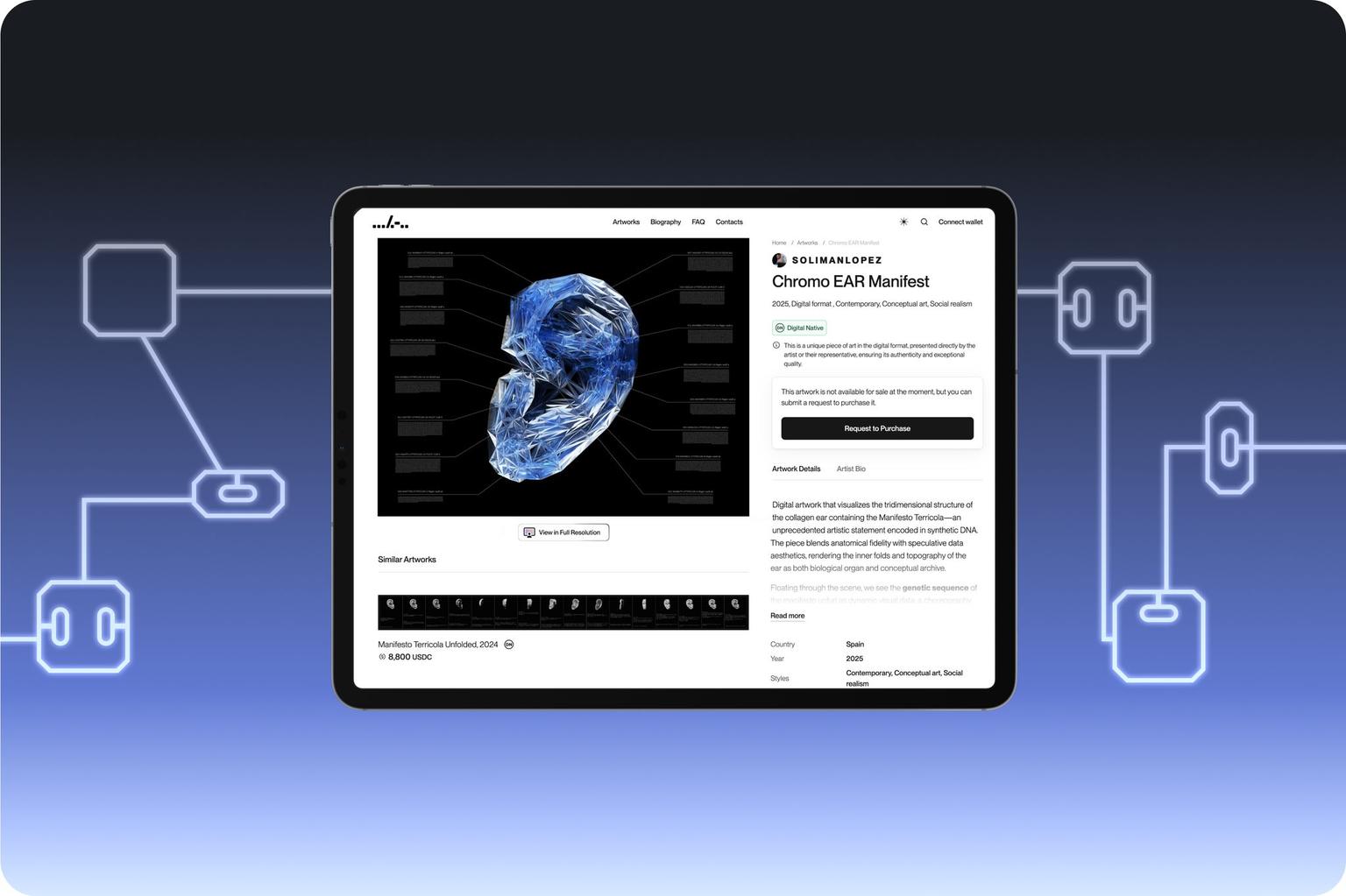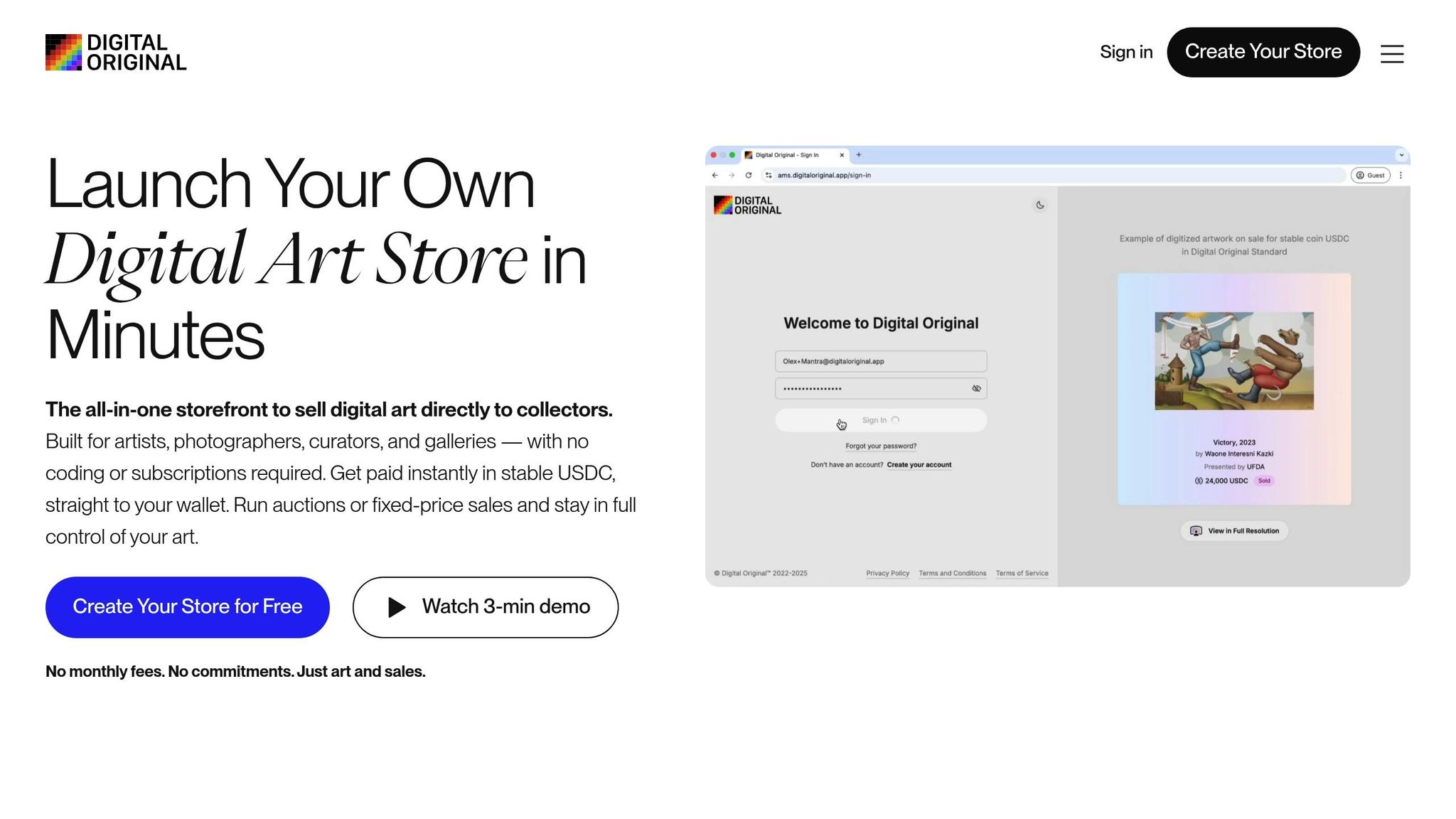Smart Contracts in Digital Art: Why Digital Original Leads the Way
 Anna C.
Anna C. 
Smart Contracts in Digital Art: Why Digital Original Leads the Way
Smart contracts are transforming digital art by automating payments, ensuring artists earn royalties on resales, and simplifying ownership verification. Solutions like Digital Original use blockchain to address common issues like delayed payments, speculative resales, and ownership disputes. Here's how they work:
- Automated Royalties: Artists get paid instantly during resales, with transparent blockchain tracking.
- Ownership Verification: Each artwork has a unique token, creating a permanent, tamper-proof record.
- Resale Rules: Anti-flipping measures, like holding periods or artist approvals, protect artwork value.
- Cost Efficiency: Eliminates intermediaries like galleries, reducing fees for both artists and buyers.
While smart contracts streamline transactions, they don't replace legal protections or manage copyright. They govern token ownership and automate processes, offering a reliable solution for the digital art market. Digital Original simplifies this with features like instant payouts, resale restrictions, and verified ownership, making it easier for artists and collectors to navigate the blockchain space.
What Are Smart Contracts in Digital Art?
Smart contracts are self-executing programs on the blockchain that handle digital art transactions without the need for middlemen. They follow predefined rules, automatically completing actions like transferring ownership once payment is made or sending royalties to artists when their work is resold.
Unlike traditional contracts, which require manual oversight from lawyers, galleries, or payment processors, smart contracts operate autonomously. Everything runs seamlessly on the blockchain, guided by the programmed conditions.
Let’s break down how these contracts function in the world of digital art.
How Smart Contracts Work in Digital Art
Smart contracts simplify digital art transactions by automating the entire process, cutting out delays and human errors.
When an artwork is created, it’s assigned a unique token - essentially a permanent digital certificate of ownership. This token includes metadata such as the artist's details, the creation date, and the ownership history.
The smart contract also sets rules for how the artwork can be sold or transferred. For instance, it might ensure the original artist receives a 10% royalty on every future resale or enforce a restriction that prevents resale within 30 days of purchase.
When a buyer wants to purchase the artwork, they interact directly with the smart contract. The contract verifies ownership, processes payments (including royalties), and transfers ownership - all recorded permanently on the blockchain. This automation ensures smooth, transparent transactions, building trust within the digital art community.
Smart Contracts vs Manual Methods
Compared to traditional methods, smart contracts offer a faster, more reliable alternative by automating processes that are prone to human error.
In manual systems, centralized platforms or gallery owners must verify ownership, process payments, and update records, which can lead to delays or mistakes. A single sale might take days to finalize. In contrast, smart contracts handle everything in minutes, ensuring accuracy and efficiency.
Smart contracts also reduce costs. Traditional transactions often involve intermediaries like galleries, payment processors, and legal services, each taking a cut. By automating these tasks, smart contracts allow more money to go directly to the artist while keeping prices more affordable for collectors.
Perhaps the biggest advantage is reliability. Manual systems rely on individuals or companies to honor agreements and process payments correctly - leaving room for errors or bad faith actions. Smart contracts, however, execute automatically based on their programming, eliminating these risks and ensuring fairness for all parties involved.
How Smart Contracts Stop Art Flipping
Smart contracts, building on the foundation of automated transactions, are proving to be a powerful defense against market speculation. Art flipping - where buyers purchase art solely to resell it for quick profit - undermines both the value of long-term works and the interests of artists and genuine collectors. With smart contracts, artists gain a dependable way to counteract this behavior by embedding resale restrictions directly into the artwork.
Unlike traditional methods that rely on platform policies or legal action, smart contracts enforce these rules automatically, leaving no room for loopholes.
Setting Resale Rules with Smart Contracts
Smart contracts allow artists to program specific anti-flipping measures directly into the digital code of their artwork. These rules are automatically triggered whenever someone attempts to resell or transfer the piece.
- Clawback clauses: One of the most effective tools, clawback clauses enable artists to reclaim ownership of the digital title if an early transfer is attempted. The artwork's title is automatically returned to the artist's crypto wallet, preventing quick resales driven by market trends.
- Veto rights on transfers: Artists can retain the ability to approve or reject resale attempts. The smart contract won't execute a transfer unless the original creator explicitly permits it, ensuring artists maintain control over their work's ownership.
- Minimum holding periods: These rules lock the artwork to the buyer's wallet for a set period after purchase, preventing immediate resales. This enforced waiting period discourages speculative flipping.
These automated safeguards stand in stark contrast to outdated manual enforcement methods, which often fall short in curbing speculative resales.
Manual vs Smart Contract Rule Enforcement
Traditional anti-flipping methods rely heavily on manual processes, creating opportunities for exploitation. In comparison, smart contracts offer a seamless, automated alternative that eliminates human error and delays.
| Aspect | Manual Methods | Smart Contract Methods |
|---|---|---|
| Detection | Days or weeks | Instant detection at transaction attempt |
| Enforcement | Requires legal or platform intervention | Automatic prevention |
| Cost | High legal fees and platform disputes | No ongoing costs after initial setup |
| Reliability | Dependent on human monitoring | Fully automated enforcement |
| Transparency | Opaque processes, unclear outcomes | Public blockchain records all actions |
| Artist Control | Limited by platform and legal systems | Direct control via programmable rules |
Smart contracts also enhance transparency and accountability by providing immutable provenance records on the blockchain. Every transaction is publicly visible, making it nearly impossible for flippers to hide unauthorized resales. This transparency acts as a deterrent, as any violations are immediately apparent to the entire community.
Unlike traditional methods, which demand constant oversight and costly legal intervention, smart contracts execute their programmed rules flawlessly, every time. This automated precision not only simplifies enforcement but also strengthens trust in digital art transactions.
How Blockchain Technology Guarantees Royalties
Traditional royalty systems have long been plagued by delays and a lack of transparency, especially when it comes to tracking secondary sales. Blockchain technology, powered by smart contracts, changes the game by automating royalty payments every time a resale occurs. This ensures artists receive their earnings reliably and without the usual wait.
When digital art tied to a smart contract is resold, the blockchain instantly calculates and transfers the pre-set royalty percentage. No more waiting weeks - or even months - for payments to process.
Automatic Royalty Payments and Tracking
Smart contracts remove the guesswork from royalty distributions. Every time a resale happens, the royalty payment is triggered automatically and recorded permanently on the blockchain. This system not only guarantees transparency but also allows artists to monitor their payments in real time through their crypto wallets. Payments are often made in stablecoins like USDC, ensuring consistency and ease of use.
This level of automation also benefits collectors. They can verify that royalties are calculated and distributed accurately, fostering trust throughout the digital art marketplace. Compared to outdated systems, the blockchain-based approach is a breath of fresh air.
Old Royalty Systems vs Blockchain Royalties
To understand the impact of blockchain on royalties, let’s break down the differences between traditional systems and smart contract-based royalties:
| Aspect | Traditional Royalty Systems | Blockchain Smart Contract Royalties |
|---|---|---|
| Payment Speed | Delays of weeks or months | Instant payouts, often within seconds |
| Tracking Visibility | Limited and unclear sales data | Real-time, transparent transaction records |
| Payment Reliability | Prone to delays and errors | Automated, ensuring accurate payouts |
| Administrative Costs | High fees that reduce artist earnings | Low fees (small gas fees only) |
| Geographic Limitations | Complicated international transfers | Seamless, borderless cryptocurrency payments |
| Dispute Resolution | Lengthy and costly legal processes | Automated processes that reduce disputes |
Traditional systems often bog down artists with administrative delays and fees, cutting into their earnings. Blockchain royalties, on the other hand, ensure that artists receive their full share almost immediately after a sale, with minimal overhead.
Digital Original exemplifies these blockchain advantages with its built-in royalty automation. By leveraging this technology, the solution ensures ongoing revenue for artists - a crucial benefit in the ever-evolving digital art world.
sbb-itb-4e84554
Digital Original: Building Trust With Smart Contracts

Digital Original takes the benefits of automated royalties and transparent transactions to the next level by using smart contracts to support both artists and collectors.
At its core, Digital Original relies on smart contract technology to simplify processes that once required intermediaries. This automation ensures transparency and security through blockchain, creating a reliable environment for everyone involved.
Smart Contract Features on Digital Original
One standout feature is instant USDC payouts. As soon as a sale is finalized, artists receive their earnings within seconds. This quick turnaround helps solve cash flow issues that many creators face.
The solution also offers public and private access controls, giving artists the power to decide who can view or purchase their work. This opens the door to exclusive collections while allowing full control over their digital storefronts.
Another major advantage is built-in royalties. Smart contracts automatically calculate and distribute a set royalty percentage every time an artwork is resold on the secondary market. This ensures artists continue to earn from their work long after the initial sale.
How Digital Original Fixes Industry Problems
Digital Original applies blockchain transparency and automation to tackle persistent challenges in the art world.
With instant smart contract execution and a no-risk, zero-cost setup, artists can start earning USDC payouts immediately after a sale.
The blockchain-based records bring a new level of transparency. Every transaction - whether it’s a sale, resale, or royalty payment - is permanently documented, allowing both artists and collectors to verify the history of any piece at any time.
Designed with digital-native artists in mind, Digital Original removes the technical hurdles often associated with blockchain. Smart contracts handle the heavy lifting behind the scenes, freeing artists to focus on what they do best: creating and sharing their art.
What Most People Get Wrong About Smart Contracts in Art
Smart contracts in digital art often spark confusion, even among seasoned collectors and creators. Misunderstandings about how they work can lead to mistakes when buying or selling digital art.
Let’s break down some common misconceptions to better understand what smart contracts actually do.
Smart Contracts Are Not Legal Contracts
The term "smart contract" can be misleading. These are not legal documents enforceable in court - they’re automated programs designed to execute specific actions. For instance, they can send royalty payments to artists automatically, but if disputes arise, traditional legal agreements are still necessary. Think of them as digital tools that follow pre-set rules, not as replacements for legal protections.
A common mistake is assuming that smart contracts protect artists from copyright infringement or unauthorized use of their work. In reality, smart contracts only govern actions within the blockchain environment where they operate. They don’t extend protections beyond that.
The Difference Between Ownership and Copyright
Here’s a crucial point: smart contracts only handle token transfers, not the underlying copyright of the artwork. Buying a digital art piece through a smart contract transfers ownership of a token tied to the artwork - but it doesn’t transfer the copyright.
When you purchase digital art, you gain ownership of a token that represents the piece. This allows you to resell the token or showcase your ownership, but it doesn’t grant rights to reproduce, modify, or use the artwork commercially. The artist typically retains full copyright unless they explicitly transfer those rights in a separate legal agreement.
Some smart contracts clarify what rights come with ownership. For example, certain contracts may include commercial usage rights, while others only transfer the token itself. Before making a purchase, it’s essential to check what rights are actually included.
Smart Contracts Go Beyond Payments
While automating payments is a key feature, smart contracts do much more. They can enforce rules designed to protect the value of the artwork and ensure fair transactions.
For example, smart contracts can include anti-flipping measures, such as blocking resales for a specific period or limiting how many times a piece can be resold. Some even restrict sales to pre-approved buyers. These features help artists avoid speculative trading and maintain the value of their work.
Another major benefit is the creation of permanent, tamper-proof ownership records. Every transaction is logged on the blockchain, providing a complete, unchangeable history of the piece’s ownership. This ensures transparency and eliminates the risk of forged or disputed provenance.
Key Takeaways
Smart contracts are reshaping the way digital art is bought and sold by automating payments and resale conditions, ensuring artists receive royalties even in secondary sales.
For artists, smart contracts offer robust protections. Features like anti-flipping measures discourage speculative trading by limiting immediate resales or capping how often a piece can change hands. Built-in royalty mechanisms ensure artists continue to earn from every resale of their work.
Collectors also stand to gain. Smart contracts provide a transparent, unchangeable record of transactions, addressing concerns about authenticity and ownership. This level of transparency helps build trust in the marketplace.
Resale restrictions are enforced automatically. Smart contracts can set rules like restricting sales to pre-approved buyers, establishing minimum holding periods, or adjusting prices based on market trends. These safeguards protect both artists and serious collectors from market manipulation.
However, it’s important to understand the limitations of smart contracts. They are digital tools designed to manage token ownership - not legal contracts - and they don’t govern copyright. Being clear on these boundaries helps both artists and collectors manage their expectations.
To make things easier, Digital Original streamlines the use of smart contracts. With features like built-in royalties, verified ownership, and instant USDC payouts, artists can sell their work immediately and focus on creating. Customizable storefronts also let artists showcase their work without worrying about upfront costs.
FAQs
How do smart contracts make sure artists get paid royalties when their digital art is resold?
Smart contracts make sure artists get their royalties when their work is resold by automatically applying payment rules every time the NFT is transferred to a new owner. These contracts include the royalty percentage determined by the artist, so whenever the NFT is sold again, the smart contract calculates the correct amount and sends it straight to the artist.
This system is completely automated, clear, and secure, guaranteeing artists are paid fairly for secondary sales - provided the marketplace supports smart contracts.
How do smart contracts help prevent art flipping and protect the value of digital artworks?
Smart contracts rely on automated rules to protect digital artworks from practices like art flipping. These rules might include:
- Resale royalties: Artists automatically earn a percentage from every resale, ensuring they’re fairly compensated over time.
- Transfer restrictions: Conditions can be set to control when and how an artwork is resold, discouraging quick flips.
- Resale price controls: Minimum price thresholds can be established to preserve the artwork’s value in secondary markets.
With the help of blockchain technology, these rules are enforced transparently and securely. This allows artists to maintain greater control over their creations and safeguard their value in the long run.
How are smart contracts different from traditional legal contracts when it comes to ownership and copyright in digital art?
Smart contracts and traditional legal contracts operate in fundamentally different ways, especially when it comes to enforcing terms. Smart contracts are essentially self-executing programs hosted on blockchain networks. Their standout feature? They automatically carry out agreed-upon terms - like transferring ownership or paying royalties - without needing a middleman. Plus, once they're set up, they're immutable, meaning the terms are locked in and can't be altered.
On the other hand, traditional contracts depend on legal systems to enforce their terms, often requiring manual processes and third-party involvement. While this approach offers some flexibility, it doesn't match the speed and automation that smart contracts bring to the table. For digital art, smart contracts are game-changers. They let artists maintain control over their work, secure resale royalties, and prevent unauthorized use - all without the hassle of drawn-out legal procedures.



